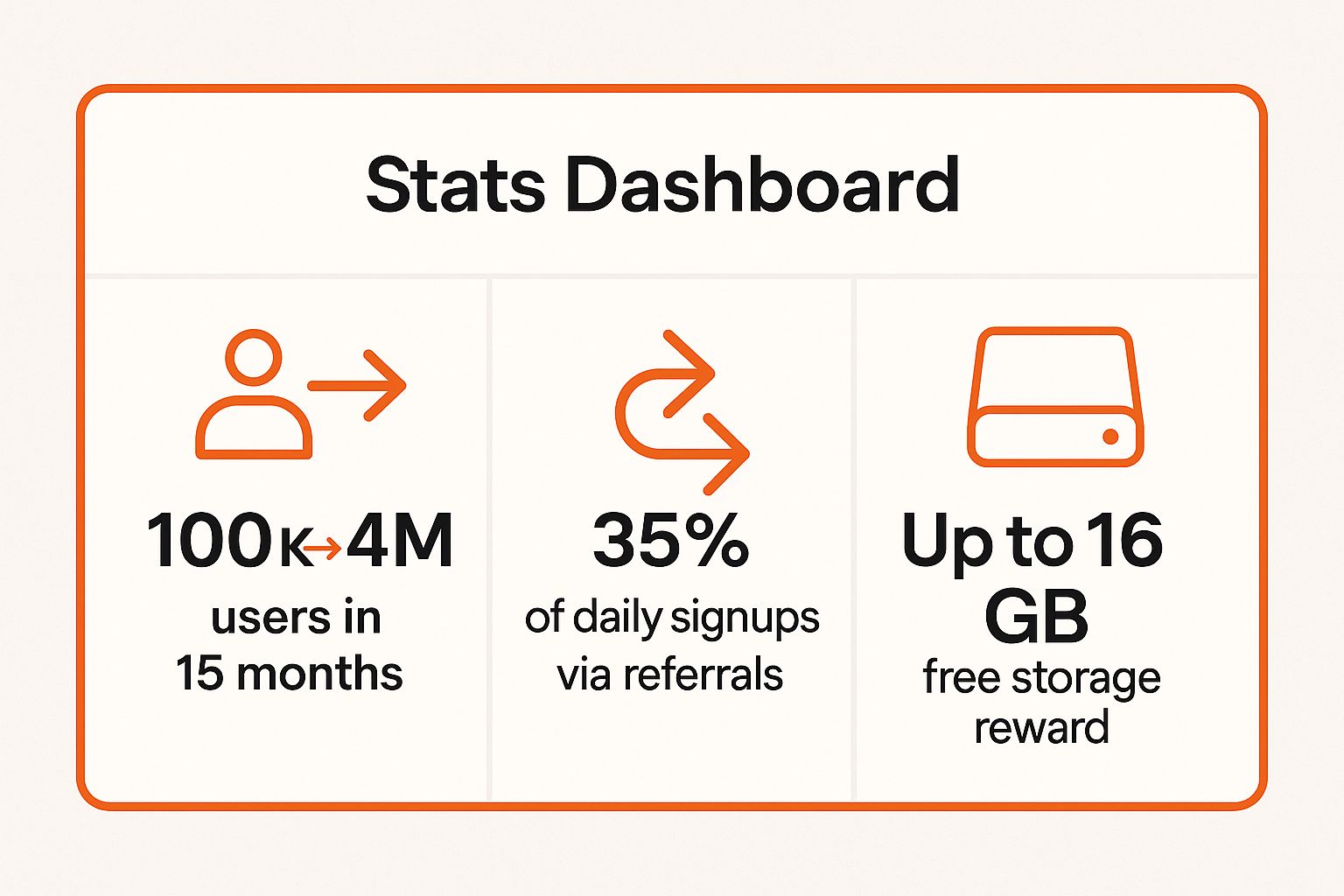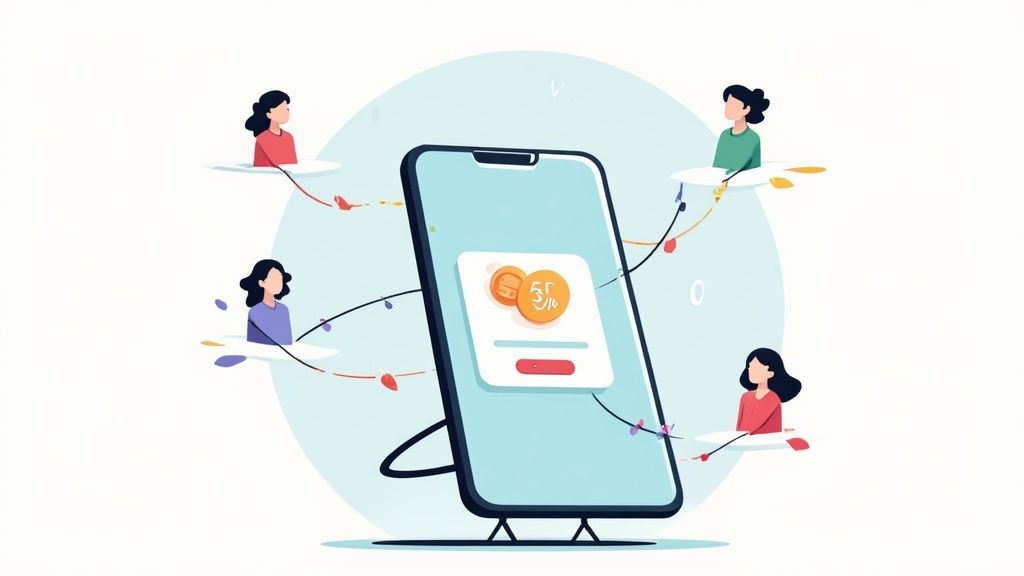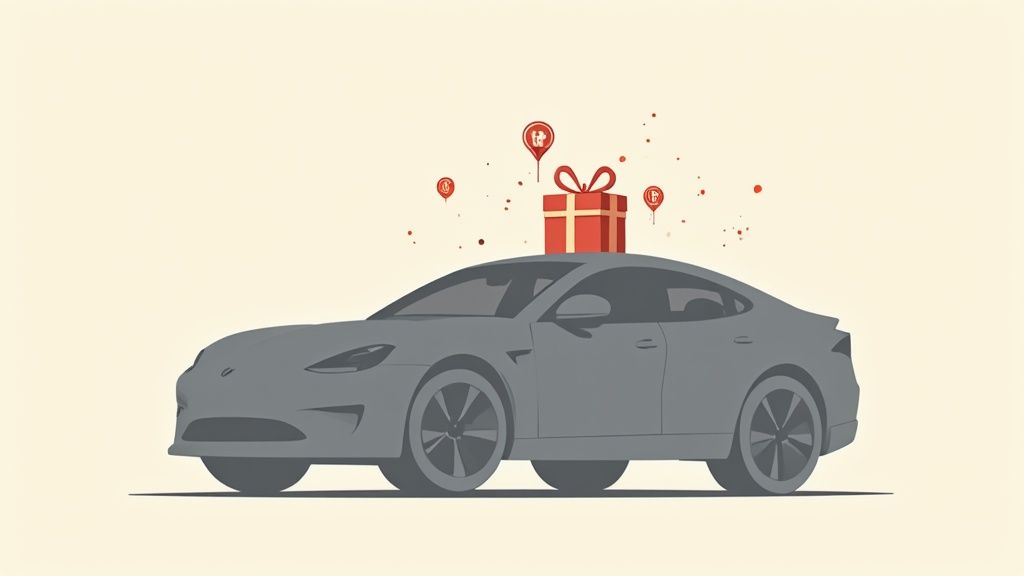6 Powerful Example of Referral Marketing Campaigns (2025)
Referral marketing remains one of the most powerful and cost-effective strategies for customer acquisition. It's not just about getting customers to share a link; it's about transforming your existing user base into a motivated, high-performance sales team. The most successful programs operate on a simple principle: people trust recommendations from friends and family far more than they trust traditional advertising. This built-in trust leads to higher conversion rates, lower acquisition costs, and customers who are more loyal from day one.
But what separates a mediocre referral program from a legendary one? It's all in the strategic details: the incentive structure, the ease of sharing, and the psychological triggers that motivate action. In this article, we will move beyond generic advice and dissect six iconic referral marketing campaigns. For each example of referral marketing, we'll analyze the specific tactics that fueled their explosive growth, break down the strategic genius behind their approach, and provide actionable takeaways you can apply to your own business.
Whether you're a startup looking to gain initial traction or an established brand aiming to optimize your growth engine, these examples provide a blueprint for success. For businesses looking to expand their growth engine beyond traditional referrals, exploring parallel affiliate marketing strategies can open new avenues for customer acquisition. We'll explore how to implement these sophisticated strategies, turning your satisfied customers into your most valuable advocates.
1. Dropbox's Give-and-Get Storage Program
Dropbox's referral program is a legendary example of referral marketing that set a new standard for user acquisition in the tech industry. Instead of offering cash, Dropbox incentivized users with something far more valuable within its ecosystem: free cloud storage. The dual-sided incentive structure was key to its viral success.
The mechanics were brilliantly simple. An existing user could invite a friend to join Dropbox. When the friend signed up and installed the desktop app, both the referrer and the new user received an additional 500MB of storage space. This reward was capped at 16GB, encouraging sustained advocacy. This strategy transformed users from passive consumers into active brand promoters, directly tying their benefit to the company's growth.
Strategic Analysis
The genius of this program was its seamless integration into the product's core value proposition. The reward wasn't an abstract discount or cash payout; it was more of the product itself. This created a self-reinforcing loop where more usage led to a need for more storage, which in turn encouraged more referrals. The process was frictionless, embedded directly within the user experience, making it easy to share via email, social media, or a unique link.
Key Insight: Dropbox succeeded by aligning the referral incentive directly with the core product value. The reward (more storage) enhanced the user’s experience, making the act of referring feel natural and mutually beneficial rather than transactional.
The following infographic highlights the explosive growth and engagement driven by this highly effective referral strategy.

These numbers illustrate how a well-designed, product-led referral program can become a company's primary growth engine, drastically reducing customer acquisition costs.
Actionable Takeaways
For e-commerce and subscription-based businesses, the Dropbox model offers a powerful blueprint.
- Offer Product-Based Rewards: Instead of cash, provide rewards that enhance the customer's experience with your product. This could be store credit, exclusive access to new products, or free premium features.
- Implement Dual-Sided Incentives: Reward both the referrer and the new customer. This "give-and-get" model makes the referrer feel generous, not greedy, significantly increasing share rates.
- Simplify the Sharing Process: Make it incredibly easy for users to find and share their unique referral link. Integrate the call-to-action at key moments in the customer journey, such as after a purchase or a positive interaction.
- Track Your Viral Coefficient: Monitor how many new users each existing user brings in. Continuously test and optimize your offer, messaging, and sharing channels to improve this metric.
2. Uber's Ride Credit Referral System
Uber's referral program is a premier example of referral marketing that fueled its aggressive global expansion. The strategy was built on a simple, powerful incentive: free ride credits. By offering a dual-sided reward, Uber ensured that both existing riders and the new users they referred received tangible value, creating a frictionless path to user acquisition.
This system was instrumental in helping Uber launch and quickly dominate new cities worldwide. The mechanics were straightforward: an existing user shares their unique referral code, and when a new user signs up and takes their first ride, both parties receive a credit toward a future trip. This created a powerful word-of-mouth engine that scaled rapidly, helping Uber achieve over 50% growth in new markets.

Strategic Analysis
The brilliance of Uber's program was its hyper-localized and frictionless nature. Unlike a one-size-fits-all approach, Uber dynamically adjusted the credit amounts based on local market conditions, supply-and-demand, and competitive pressures. This flexibility allowed them to be aggressive in new territories while remaining cost-effective in mature markets. The entire process was seamlessly integrated into the mobile app, making sharing a code as easy as sending a text.
Key Insight: Uber’s success came from treating its referral program not as a static campaign but as a dynamic growth lever. By tailoring incentives to local markets and making the sharing experience mobile-native, it created a scalable system for market penetration.
This approach transformed its user base into a decentralized and highly motivated sales force, perfectly suited for rapid, city-by-city expansion. For a deeper understanding of the mechanics behind such programs, you can learn more about mastering referral program tracking to replicate this success.
Actionable Takeaways
Uber's model provides a powerful template for service-based and mobile-first businesses aiming for rapid growth.
- Localize Your Incentives: Do not assume one reward value works everywhere. Analyze each market's customer lifetime value (LTV) and acquisition costs to offer compelling yet sustainable incentives.
- Optimize for Mobile Sharing: Your referral flow must be effortless on a mobile device. Integrate sharing options with native mobile functions like SMS, WhatsApp, and social media apps.
- Create a Sense of Urgency: Use time-sensitive offers or limited-time increased rewards to motivate immediate action from both the referrer and the new user.
- Leverage Social Proof in Messaging: Frame the referral as a personal recommendation. Use messaging like, "Your friend [Name] sent you a free ride!" to build trust and increase conversion rates.
3. Airbnb's Travel Credit Program
Airbnb’s referral program is a premier example of referral marketing for a two-sided marketplace, designed to simultaneously grow its supply of hosts and its demand from guests. Instead of a one-size-fits-all reward, Airbnb offered valuable travel credits, cleverly tailored to incentivize both sides of its platform. This dual-sided approach was a cornerstone of its global expansion and community-building efforts.

The mechanics were expertly crafted. An existing user could invite friends to join Airbnb. When a referred friend completed their first qualifying booking as a guest, the referrer received travel credit. Crucially, if a referred friend listed their own space and hosted their first guest, the referrer received an even larger credit. This system motivated users to not only bring in new travelers but also to recruit new hosts, addressing the platform's critical need for inventory.
Strategic Analysis
The program's brilliance lies in how it fueled both sides of the marketplace flywheel. By providing distinct, high-value incentives for guest and host referrals, Airbnb ensured its growth was balanced. The travel credits acted as a powerful reinvestment tool, encouraging referred users and referrers alike to immediately engage with the platform again, either by booking a trip or hosting.
This strategy helped Airbnb scale from a few million users to over 150 million, contributing significantly to the 25-30% of new bookings that came directly from referrals. The program's success was amplified by localizing rewards and messaging for over 220 countries and regions, making the incentives culturally relevant and effective worldwide.
Key Insight: Airbnb mastered the two-sided marketplace referral by creating separate, compelling incentive tracks for acquiring customers (guests) and suppliers (hosts). The reward, travel credit, perfectly aligned with the platform's core offering, driving immediate re-engagement and sustaining the growth loop.
Actionable Takeaways
For marketplace platforms and service-based businesses, Airbnb’s model provides a clear roadmap.
- Balance Your Marketplace Incentives: If you operate a two-sided platform (e.g., buyers and sellers, students and tutors), create distinct referral incentives for each side. Offer a more substantial reward for referring the side that is harder to acquire.
- Localize Rewards and Messaging: Adapt your referral offers and promotional language to different geographical markets. What works in one country may not be as effective in another; consider currency values and cultural norms.
- Create an Emotional Connection: Frame your referral program around community and shared experiences, not just transactions. Use language like "Invite friends, travel together" to make the act of referring feel personal and beneficial for the relationship.
- Use Data to Optimize Timing: Analyze user behavior to identify the best moments to prompt a referral. This could be after a 5-star review, a completed trip, or when a host receives a booking inquiry.
4. Tesla's Referral Program with Exclusive Rewards
Tesla's referral program is a premier example of referral marketing that leverages exclusivity and brand prestige to drive sales. Instead of relying solely on monetary incentives, Tesla offers rewards that are deeply aspirational and tied to its innovative identity. The program has evolved over the years, but its core principle remains: turn passionate customers into powerful brand advocates by offering money-can't-buy experiences and exclusive products.
The mechanics have varied, from providing thousands of dollars in discounts to offering free Supercharging credits. More uniquely, rewards have included limited-edition products like signature wall connectors, exclusive "Founder's Series" wheels, and even invitations to private company events. The most audacious reward was the chance for top referrers to send a photo of their choice into deep space aboard a SpaceX rocket, generating immense PR and reinforcing the brand's futuristic image.

Strategic Analysis
The brilliance of Tesla's program lies in its understanding of its customer base. Tesla owners are not just car buyers; they are early adopters and tech enthusiasts who feel part of a movement. The rewards tap into this identity, offering status and access rather than just cash. This transforms the referral from a simple transaction into an act of sharing one's passion and insider status.
The program creates a powerful sense of community and gamification. By setting tiered rewards and creating "secret levels" with unpublished prizes, Tesla encourages sustained referral activity. This model doesn't just acquire new customers; it deepens the loyalty of existing ones, making them feel valued and recognized for their advocacy. It's a perfect example of building a strong customer advocacy program that goes beyond simple transactions.
Key Insight: Tesla's program excels by offering exclusive, non-monetary rewards that align with the brand's aspirational values. This strategy creates a feeling of exclusivity and insider status, motivating customers far more effectively than a standard cash discount could.
The following video explores how the program has evolved and leveraged the power of its community.
Actionable Takeaways
For high-end or lifestyle brands, Tesla's approach offers a masterclass in aspirational marketing.
- Align Rewards with Brand Identity: Offer rewards that your customers cannot get anywhere else. This could include limited-edition merchandise, access to product designers, or invitations to exclusive brand events.
- Create Urgency and Scarcity: Structure your program with limited-time offers or tiered rewards that expire. This encourages immediate action and makes the rewards feel more valuable.
- Gamify the Experience: Introduce leaderboards, secret reward levels, or stretch goals to keep referrers engaged and motivated over the long term.
- Leverage Exclusivity: Frame your rewards as a privilege for your most loyal customers. This enhances their perceived value and makes participation feel like joining an exclusive club.
5. PayPal's Cash Bonus Referral Program
PayPal's "Refer a Friend" program is a pioneering example of referral marketing that literally paid people to join its network. In its early, high-growth phase, PayPal offered a direct cash incentive, depositing real money into the accounts of both the referrer and the new user. This aggressive strategy was instrumental in overcoming the initial friction of adopting a new digital payment system.
The mechanics were straightforward and powerful. Initially, PayPal offered $10 to the referrer and $10 to the new user upon signup. This amount fluctuated, but the core concept remained: a direct, tangible cash reward. This tactic created a powerful growth engine, reportedly driving 7-10% daily growth at its peak and helping the platform scale from one million to over 100 million users, a key factor in its $1.5 billion acquisition by eBay.
Strategic Analysis
The brilliance of PayPal's approach was its aggressive simplicity and direct alignment with its service. The reward wasn't a discount or store credit; it was cash, the very commodity the platform was designed to transfer. This made the incentive universally appealing and incredibly easy to understand. By directly depositing the bonus, PayPal also forced new users to engage with the platform immediately to access their reward, teaching them how the service worked and lowering activation barriers.
Key Insight: For a financial product, a direct cash incentive can be the most effective reward. PayPal leveraged this by making the reward itself a demonstration of the product's core functionality, creating an immediate and compelling reason for both acquisition and activation.
This bold, high-cost acquisition strategy was a calculated risk. The company essentially "bought" its initial user base, banking on the network effect and the future lifetime value of each customer to justify the expense.
Actionable Takeaways
For businesses, especially in the FinTech or service sectors, the PayPal model provides a potent, if costly, blueprint for rapid user acquisition.
- Use Cash for Financial Products: If your product deals directly with money, a cash reward is often the most logical and motivating incentive. It's universally understood and highly desirable.
- Balance Reward vs. Customer Lifetime Value (CLV): A high-cost acquisition strategy like this only works if you have a clear understanding of your CLV. Ensure the referral bonus is a sustainable investment that pays off over the long term.
- Implement Strong Fraud Verification: Paying out cash creates a high risk of fraudulent signups. Implement robust verification processes, such as requiring a linked bank account or a small transaction, before paying the bonus.
- Focus on Quality Activation: The goal isn't just signups; it's active users. Structure the program to require an action (like linking a card or making a transfer) to unlock the reward, ensuring new users are engaged from the start.
6. Harry's Pre-Launch Referral Campaign
Harry's, the men's grooming brand, orchestrated a masterful pre-launch campaign that stands as a premier example of referral marketing for building massive anticipation. Instead of launching to an empty room, they used a tiered, referral-based system to build an email list and generate buzz before a single product was available for sale. The campaign was built on a simple premise: the more friends you refer, the better your prize.
The mechanics were designed to gamify sharing and create momentum. Users would sign up on a landing page with their email address and receive a unique referral link. As they shared the link and their friends signed up, they unlocked progressively valuable rewards. This tiered structure motivated users to keep sharing, culminating in an astonishing outcome: the campaign generated nearly 100,000 email addresses in a single week, setting the stage for a blockbuster launch.
Strategic Analysis
The genius of Harry's campaign was its use of scarcity and exclusivity during the pre-launch phase. By offering tangible rewards before the store was even open, it created a dedicated community of brand advocates eager for the launch. The campaign's microsite featured a clean design that clearly explained the rewards and showed users their referral progress, using social proof to drive further action. The rewards were perfectly aligned with the brand, ranging from free shave cream to a year's supply of free blades.
Key Insight: Harry's demonstrated that a referral program can be a powerful tool for market entry, not just post-launch growth. By gamifying the pre-launch phase with tiered, product-related rewards, they built an engaged audience and secured a massive list of warm leads before day one.
This strategy effectively transformed the traditional product launch model. Instead of spending heavily on ads to a cold audience, Harry's invested in rewarding its earliest and most enthusiastic supporters, who in turn did the marketing for them.
Actionable Takeaways
For new brands or those launching new products, the Harry's pre-launch model is a highly effective playbook.
- Create Progressive Reward Tiers: Don't just offer a single reward. Structure your incentives in tiers to motivate sustained sharing. For example, 5 referrals get you Product A, 10 referrals get you Product B, and so on. This gamifies the experience.
- Leverage Exclusivity and Scarcity: A pre-launch window is a unique opportunity. Frame your campaign around getting early access or exclusive rewards that won't be available after the launch.
- Align Rewards with Your Product: Ensure the prizes are items your target audience genuinely wants and that they are directly related to your brand. This builds authentic excitement for your core offering. For more ideas on structuring incentives, you can learn how to start a rewards program on buildwithtoki.com.
- Build Social Proof Into the Funnel: Clearly show users how many people they have referred and what prize they are close to unlocking. This visual progress encourages them to reach the next milestone.
Referral Marketing Program Comparison
| Program Title | Implementation Complexity 🔄 | Resource Requirements ⚡ | Expected Outcomes 📊 | Ideal Use Cases 💡 | Key Advantages ⭐ |
|---|---|---|---|---|---|
| Dropbox's Give-and-Get Storage Program | Low - Simple sharing and reward process | Moderate - Ongoing free storage costs | High user growth & referral-driven signups | SaaS, Cloud storage, product-based rewards | Cost-effective acquisition, viral growth |
| Uber's Ride Credit Referral System | Medium - Requires dynamic, localized adjustments | High - Variable ride credits & monitoring | Rapid market expansion and high acquisition | On-demand services, competitive markets | Flexible rewards, strong network effects |
| Airbnb's Travel Credit Program | High - Managing dual-sided marketplace incentives | High - Different rewards for hosts and guests | Balanced supply-demand growth globally | Marketplaces with multi-sided users | Marketplace balance, community engagement |
| Tesla's Referral Program with Exclusive Rewards | High - Complex tiered rewards & fulfillment | Very High - Premium rewards and events | Strong brand loyalty and media buzz | Premium brands, high-value customers | Brand prestige, exclusive experiences |
| PayPal's Cash Bonus Referral Program | Low - Straightforward cash rewards | High - Direct monetary costs | Fast user acquisition and platform adoption | Financial services, quick growth targets | Universal appeal, instant gratification |
| Harry's Pre-Launch Referral Campaign | Medium - Progressive tiers, pre-launch focus | Moderate - Rewards and campaign management | Large email list & buzz before launch | New product launches, audience building | Builds anticipation, validates market demand |
Building Your Own High-Impact Referral Program
Throughout this deep dive, we've analyzed a powerful example of referral marketing from six different industry-defining brands. From Dropbox's product-led incentive to Tesla's appeal to exclusivity and Harry's masterful pre-launch campaign, a clear pattern emerges. The most successful referral strategies are not generic add-ons; they are meticulously crafted, brand-aligned growth engines.
These examples show that a program's power lies in its thoughtful design. It's about understanding the core motivations of your audience and creating a value exchange that feels both generous and authentic. A truly effective referral program is a win-win-win scenario: the existing customer is rewarded, the new customer gets a warm welcome, and the business acquires a high-value user at a lower cost.
From Inspiration to Implementation: Your Action Plan
Seeing a great example of referral marketing is inspiring, but turning that inspiration into a high-performing program for your own brand requires a strategic approach. The lessons from these titans of industry are not just for Silicon Valley giants; they are scalable principles for any e-commerce or direct-to-consumer business.
Here’s how to translate these insights into action:
- Define Your "Why": Start with your primary business objective. Is it to lower customer acquisition costs, increase customer lifetime value, or drive rapid user growth? Your goal will shape every subsequent decision, from the rewards you offer to the way you promote the program.
- Identify Your Customer's "What": What truly motivates your customers? For some, like PayPal users, a simple cash bonus is the perfect incentive. For others, like Tesla enthusiasts, exclusive access or unique products hold far more appeal. Survey your audience or analyze purchase behavior to discover what they value most.
- Design a Seamless Experience: As we saw with Uber and Airbnb, a frictionless user journey is non-negotiable. The process of sharing a referral and claiming a reward must be incredibly simple, intuitive, and integrated directly into the natural user flow of your app or website.
- Integrate and Amplify: Your referral program shouldn't exist in a vacuum. It's a critical component of your overall retention strategy. For merchants on Shopify, understanding how these initiatives fit within broader Shopify loyalty programs is key to creating a cohesive ecosystem that fosters deep, long-term customer relationships and maximizes growth potential.
Ultimately, the power of referral marketing lies in its authenticity. It transforms your happiest customers into your most effective advocates, leveraging the unparalleled power of word-of-mouth in a digital, scalable format. By moving beyond generic templates and applying these strategic principles, you can build more than just a marketing channel; you can build a community-powered growth engine that fuels your brand for years to come.
Ready to turn your loyal customers into a powerful growth channel? Toki provides the tools to build, manage, and optimize sophisticated referral and loyalty programs directly on Shopify. Launch your own high-impact program and watch your community grow by visiting Toki today.